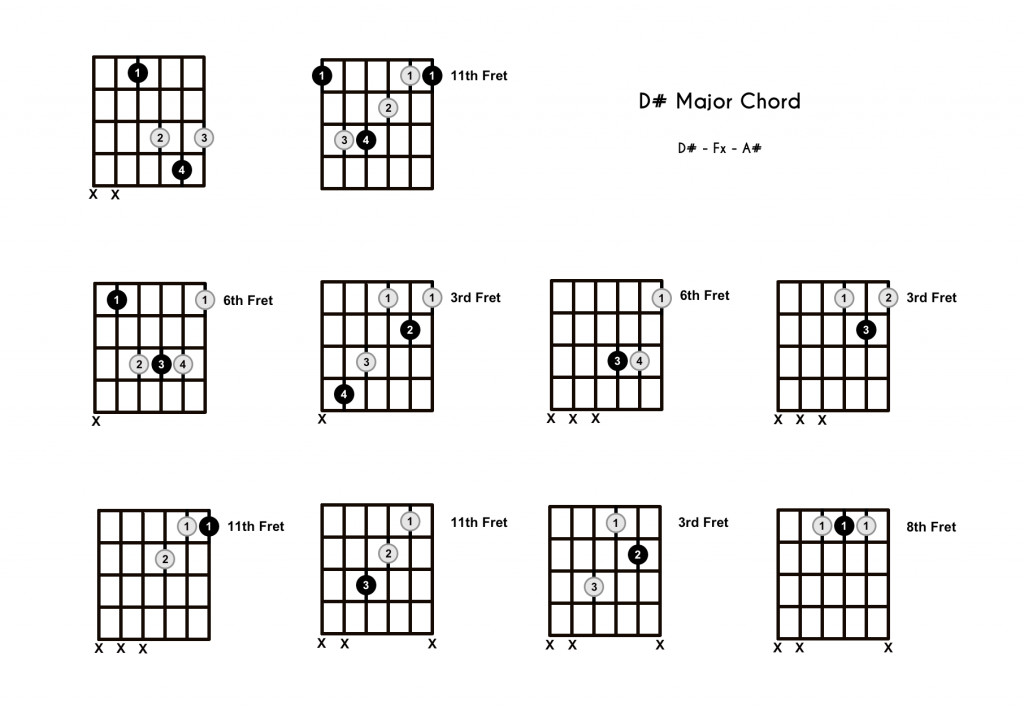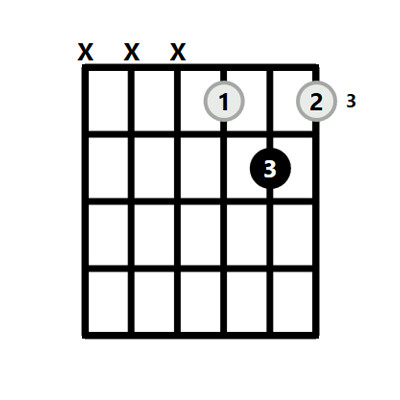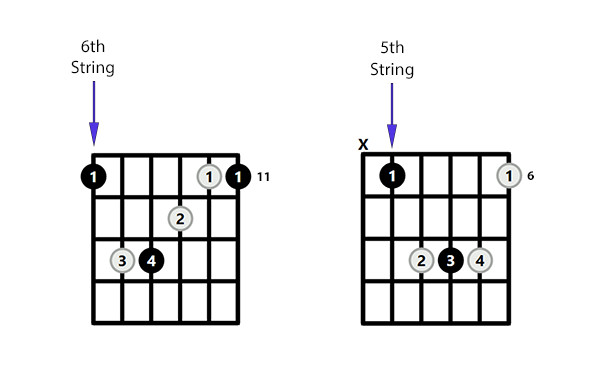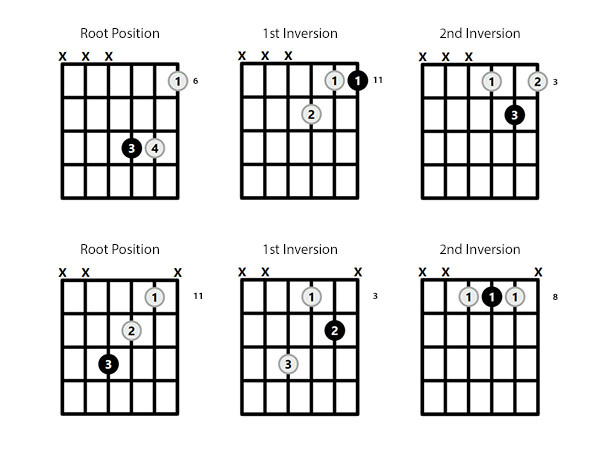The D# Major chord, often referred to as the D sharp Major chord, shares its sound with the Eb Major chord – they are enharmonically equivalent. While both names represent the same chord, you’ll likely encounter “Eb” more frequently. This is partly due to the key of D# Major and its somewhat complex notation. Don’t let the name intimidate you; understanding and playing the D# guitar chord is a valuable skill for any guitarist. This guide will break down the D# chord, exploring various ways to play it, its underlying theory, and how to use it in your music.
Understanding the D# Major Chord: Theory Breakdown
To truly master the D# chord on guitar, it’s helpful to understand the music theory behind it. Like all major chords, the D# Major chord is built upon a specific formula and has a unique place within musical scales and keys.
Notes in the D# Chord
The D# Major chord is composed of three distinct notes:
- D# (Root): This is the foundational note of the chord, giving it its name.
- Fx (Major Third): “Fx” stands for F double sharp. In practical terms on the guitar, Fx is the same pitch as G natural. This note creates the major quality of the chord.
- A# (Perfect Fifth): This note provides harmonic stability to the chord and completes the triad.
Although Fx is theoretically F double sharp, when playing on the guitar, you are producing the same pitch as a G natural. This is a key point to remember as you explore different D# chord shapes.
D# Major Scale Connection
The D# Major chord is intrinsically linked to the D# Major scale. It’s formed by playing the 1st, 3rd, and 5th notes of this scale. Understanding scales and chords in relation to each other is crucial for developing a deeper musical understanding.
Intervals in Major Chords
Major chords, including D#, follow a consistent interval pattern from their root note:
- Major Third: The interval between the root (D#) and the second note (Fx/G).
- Minor Third: The interval between the second note (Fx/G) and the third note (A#).
- Perfect Fourth: The interval back to the root note (D#) from the third note (A#) if you continue the pattern.
This interval structure is what defines the bright and uplifting sound characteristic of major chords.
D# in the Key of D# Major
The D# Major chord is the very first chord you encounter in the key of D# Major. The complete sequence of seven chords in the key of D# Major is as follows:
- D# Major
- E# minor
- Fx minor
- G# Major
- A# Major
- B# minor
- Cx diminished
Understanding the chords within a key allows you to create chord progressions and compose music effectively.
Exploring 10 Ways to Play the D# Guitar Chord
For guitarists seeking flexibility and different sonic textures, there isn’t just one way to play the D# chord. Here are 10 different shapes for the D# Major chord, offering a range of voicings across the fretboard.
 Diagram showing 10 shapes for the D sharp major chord on guitar
Diagram showing 10 shapes for the D sharp major chord on guitar
Standard D# Chord Shape
The most frequently used D# chord shape is a barre chord variation rooted on the 5th string. Often referred to as the “root-5” barre chord, it’s commonly played starting at the 6th fret. Interestingly, the index finger in this shape sometimes acts more as a fretting finger for the root note rather than a full barre.
 Diagram of the standard D sharp chord shape on guitar
Diagram of the standard D sharp chord shape on guitar
Easy D# Chord Shape
If barre chords feel challenging, especially when starting out, there’s an easier version of the D# chord. This simplified shape focuses on the top three strings of the guitar. It’s essentially the same shape as the open D chord, but moved up one fret. This makes it a great entry point for incorporating the D# chord into your playing.
 Diagram of the easy D sharp chord shape on guitar
Diagram of the easy D sharp chord shape on guitar
Step-by-Step Guide to Playing the Standard D# Chord
Sometimes, chord diagrams can be quickly glanced over. If you’re unsure if you’re playing the standard D# chord shape correctly, these step-by-step instructions can be incredibly helpful:
- First Finger: Place your index finger on the 6th fret of the 5th string.
- Second Finger: Place your middle finger on the 8th fret of the 4th string.
- Third Finger: Place your ring finger on the 8th fret of the 3rd string.
- Fourth Finger: Place your pinky finger on the 8th fret of the 2nd string.
- Strumming: Avoid strumming the 6th string and strum downwards across the top five strings (5th, 4th, 3rd, 2nd, and 1st).
By following these instructions, you can double-check your finger placement and ensure you’re playing the standard D# chord accurately.
Barre Chord Shapes for D
Barre chords are essential for guitarists, allowing you to play chords in different positions along the neck. The D# chord is readily playable as a barre chord using two common barre shapes:
- Root 6 Barre Chord Shape: Based on the E major open chord shape, barre at the 11th fret.
- Root 5 Barre Chord Shape: Based on the A major open chord shape, barre at the 6th fret (this is the “standard” shape discussed earlier).
 Diagram showing D sharp barre chord shapes on guitar
Diagram showing D sharp barre chord shapes on guitar
D# Major Triads
Beyond full chord shapes, exploring triads—three-note chords—offers valuable insight and alternative voicings. D# Major triads, including inversions, provide different sonic colors and can be useful in various musical contexts. The three inversions of the D# Major triad are:
- Root Position: D#, Fx, A#
- 1st Inversion: Fx, A#, D#
- 2nd Inversion: A#, D#, Fx
Here are some examples of how to play these D# Major triad inversions on the guitar fretboard.
 Diagram showing D sharp major triad shapes on guitar
Diagram showing D sharp major triad shapes on guitar
Keys Featuring the D# Chord
Knowing which musical keys include the D# chord expands your songwriting and improvisation possibilities. The D# Major chord naturally appears in these keys:
- D# Major: (D#, E#m, Fxm, G#, A#, B#m, Cxdim)
- A# Major: (A#, B#m, Cxm, D#, E#, Fxm, Gxdim)
- G# Major: (G#, A#m, B#m, C#, D#, E#m, Fxdim)
Understanding key relationships helps you build chord progressions and solos that harmonically make sense.
Alternative D# Chord Shapes
While the shapes already discussed are common, there are other less frequent but still useful ways to play the D# Major chord. These alternative shapes can offer unique voicings or be more convenient in certain musical passages. Exploring these expands your chord vocabulary.
D# Chord Substitutions
In certain musical situations, you can substitute the D# Major chord with related chords to create interesting harmonic variations. Effective substitutions for D# include:
- D# sus 4: Adds a suspended feel, replacing the major third with a perfect fourth.
- D# sus 2: Creates a different suspended sound, replacing the major third with a major second.
- D# add 9: Adds a ninth interval for a richer, more complex major sound.
Conversely, the D# Major chord itself can sometimes act as a simplified substitute for more complex chords with D# as the root, such as D# Major 7 or D#7 chords. However, it’s important to note that D# Major cannot replace minor chords.
Scales for Soloing Over the D# Chord
For guitarists wanting to improvise or write melodies over a D# Major chord, selecting the right scales is crucial. Effective scales for soloing over D# Major include:
- D# Major Scale: The most natural choice, outlining the chord tones perfectly.
- D# Pentatonic Major Scale: A simplified major scale, great for melodic improvisation.
- D# Blues Scale: Adds a bluesy flavor, incorporating minor pentatonic elements.
- Lydian Mode (D# Lydian): Creates a brighter, more ethereal sound.
Experimenting with these scales will unlock melodic possibilities over the D# chord and enhance your improvisational skills.
Further Reading
To deepen your guitar chord knowledge and explore a vast collection of chord shapes, consider checking out “Guitar Chords Galore.”
[
